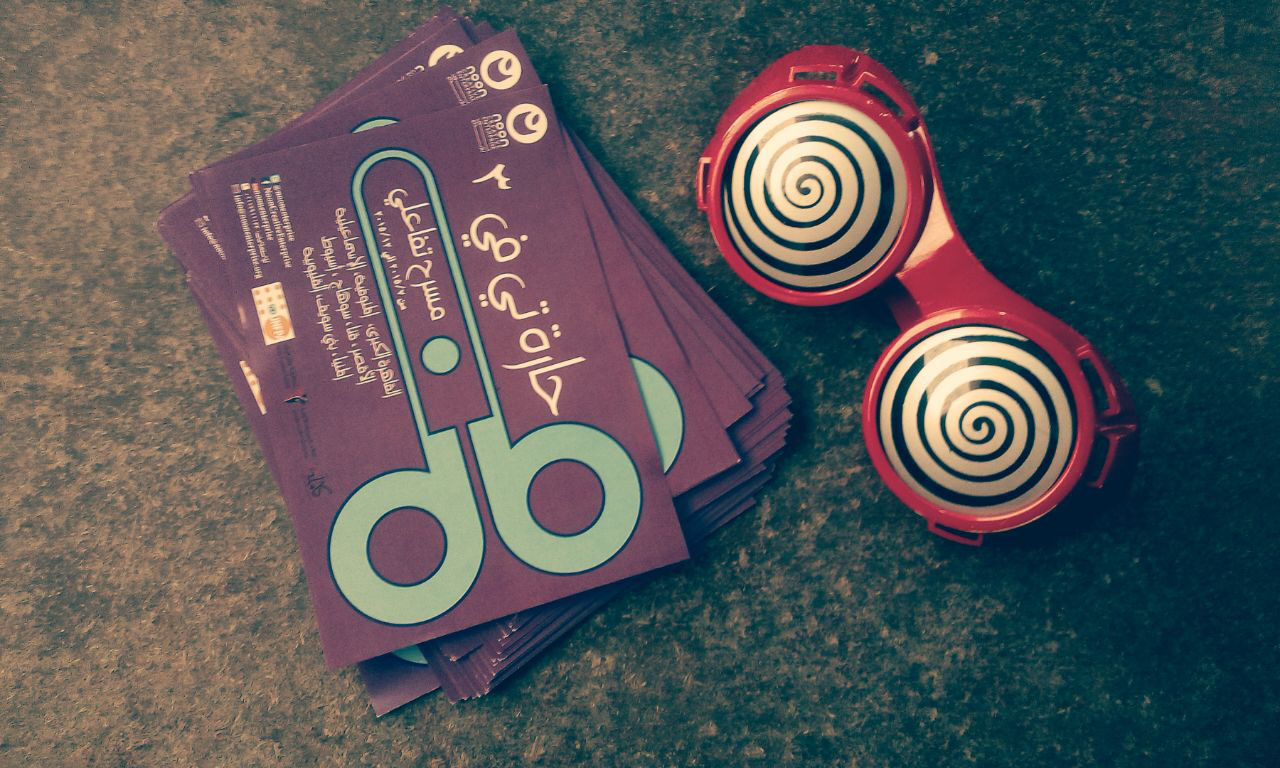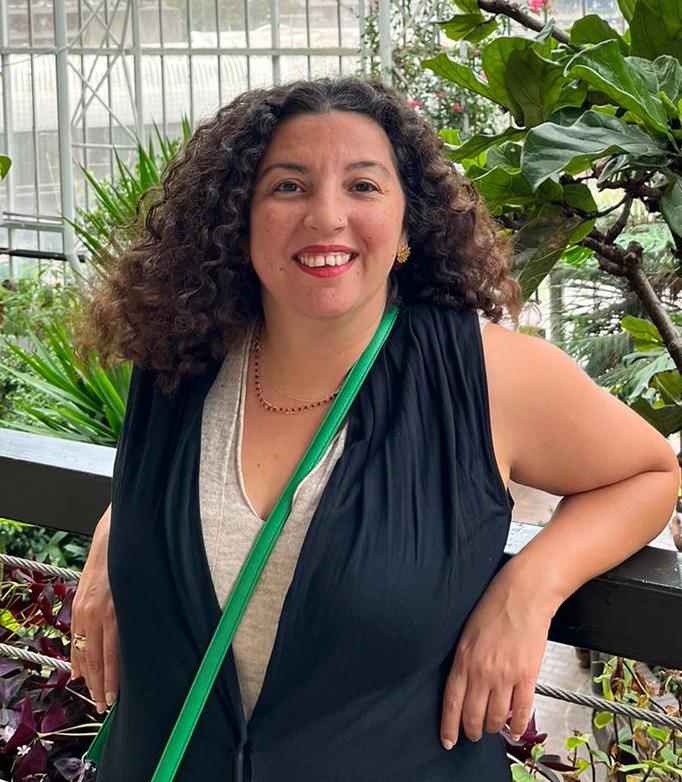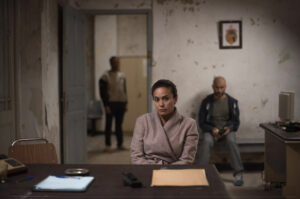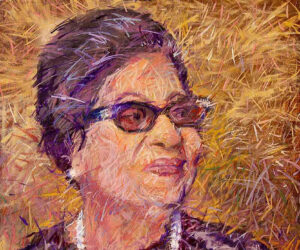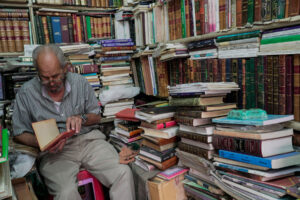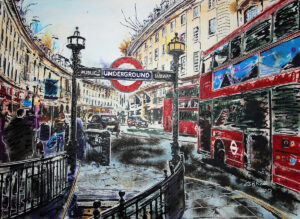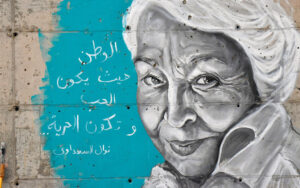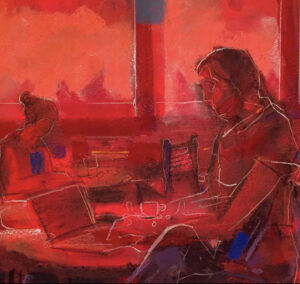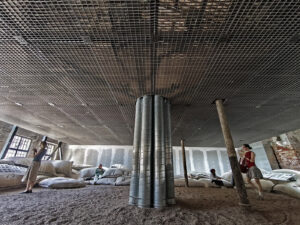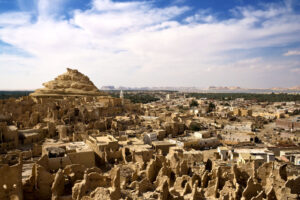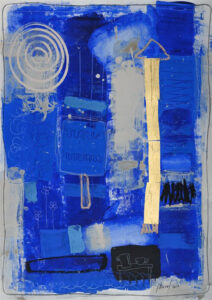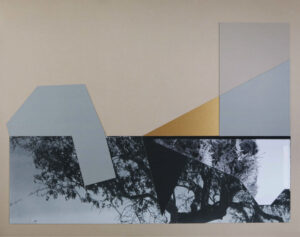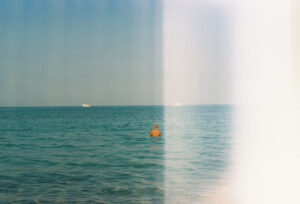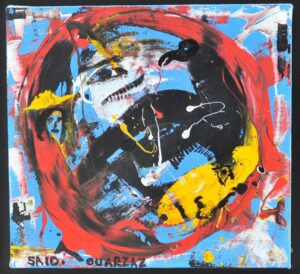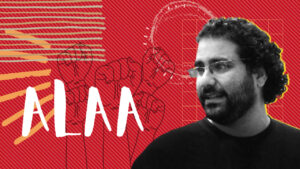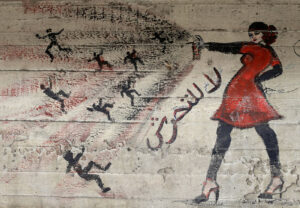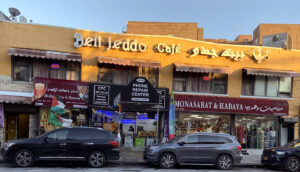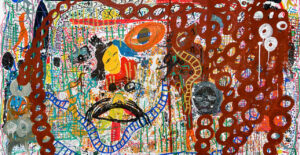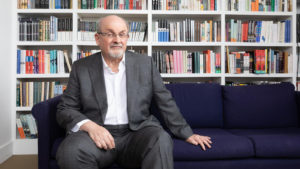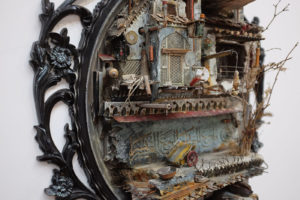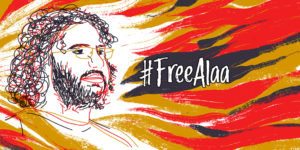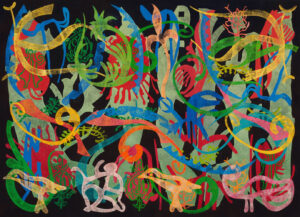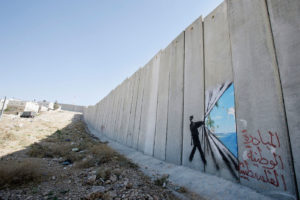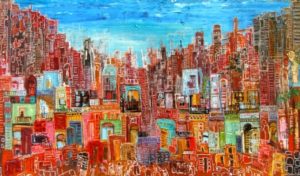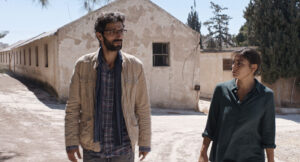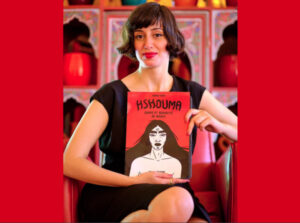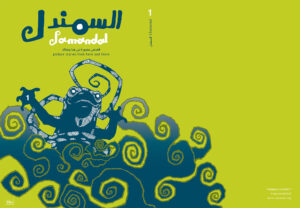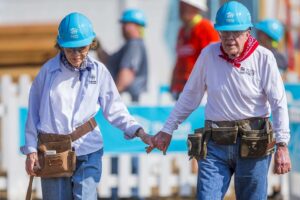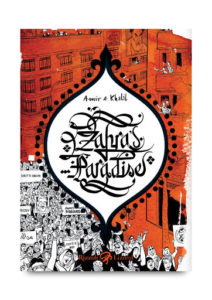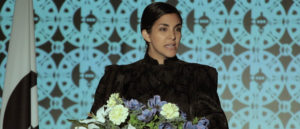Harnessing improvised theatre and comedy to address gender-based violence and FGM in Egypt.
Nada Sabet
“AaaaaaaaGGGGh! Stop the harasser!” screams actor Ahmed el Sawi, dressed in a bright pink cloth tied around his chest like a dress, as the audience roars with laughter.
The interactive play, Hara TV3, about female genital mutilation (FGM), was performed 1,400 times, in 27 of Egypt’s 28 governorates, in theaters, festivals, streets, and fields. From 2014 to 2018, the 90-minute show toured schools, youth centers, NGOs, training centers, sports facilities, medical centers, theatres, fields; and was performed indoors and outdoors with lighting and mics or without, to audiences as small as 15 or as large as 2,000. The audiences varied from doctors, university students, low income families, to women, families and newly-weds. It was welcomed into mosques, churches and community spaces.
Hara means “alleyway” in Arabic. Hara TV was commissioned by UN Population fund (UNFPA). It started with the first Hara TV, in September 2011, a year marked with change, turbulence and hope for Egypt. The Hara TV1 on youth civic participation, which gave performances on the Cairo metro, was followed by Hara TV2 in 2013 on discrimination, gender and parenting. Hara TV3 followed the year after. Each production focused on different topics yet with the same format of short skits, with musical interludes based on the premise of three young friends creating a community TV.
Hara TV3 hit the road, with its four comic scenes and multiple songs, and three versatile actors portraying the multifaceted impacts of FGM on individuals and society. The show had been made purposefully light on its feet to lend itself to easy travel, with minimal set up and get out time so that it can be adaptable to a whole range of spaces. Funny, loud and colorful, it was a show that engaged directly with the audience, slowly warming them up to discuss their own fears, traditions and understanding of FGM. As its director, I wanted to make it significantly different from theatre shows where audiences receive information passively. Often performing three or four shows a day and traveling for 10 days to two weeks at a time, across the entire country, actors had to be flexible and adapt to such a wide array of performance spaces and audiences, many of whom had never engaged with a live performance before.
For Ahmed el Sawi, the format was more fluid than the roles he had played in conventional theatre. “As an actor, [Hara TV2 and 3] really honed in on my improvisation skills. Working with varied audiences in ages and backgrounds allowed me to work on my feet. The audience interaction and flow between us actors helped keep things fresh.”
The show also developed in him a passion for social theatre, and as time went on, he became more adept in talking about FGM on stage; answering questions from the audience as well as off stage. “[It] was a very effective project, we had huge impact on FGM and getting audiences to engage in real conversation. We are also still well-known because of this show — especially in upper Egypt. I was stopped last time [I was there] and asked if I was the guy in the show. People still engage with me on social media.”
An Unlikely Theatrical Improvisation
FGM, also known as female genital cutting or female circumcision, refers to the partial or total removal of the external female genitalia or other injury to the female genital organs for non-medical reasons. The practice is often carried out on young girls between infancy and adolescence by traditional practitioners or doctors. However, because there is no standardized medical procedure, practitioners improvise which part or parts and how little or much to remove.
This was not a topic I had given much thought to. Although aware of it from TV and billboard ads I had not come face to face with it and was intrigued when initially approached by UNFPA. Reading the research that came with the commission, I was angered by what looked like 25 years of work to eradicate the practice, yet the numbers were still hideously high. My initial impulse was to try a different approach, I was not interested in recreating the screaming girl and blood splattering horror used by pervious artists. I wanted to engage audiences in the multi layers of their beliefs, decisions and actions. I also found the “girl dies” argument a bit of a cop out since that was not, in fact, what the numbers suggested. Taking on the challenge, I proposed a comedy, which lured audiences in through laughter at our Egyptian customs, using parodies from well-known ads on TV, music concerts and TV series, an interactive theatre performance that was witty, and entertaining followed by an in-depth conversation. Something light that could tour and move without much hassle.
FMG is deeply rooted in cultural, social, and sometimes religious beliefs. It has often been mistaken as a rite of passage to womanhood, in which women’s sexuality and purity are controlled, in part to ensure marriageability. The practice has been recognized globally as a violation of human rights and, specifically in Egypt, criminalized since 2008. Yet, its prevalence in the country has been high. In 2014, the year Hara TV3 took to the road, it was estimated that up to 90 percent of women underwent the procedure, particularly older women, while numbers were slightly less for women aged 30 at 83 percent and younger girls at 72 percent.
FGM might be thought of as a topic that does not lend itself to comedy but Egyptians love comedy and pride themselves on their sense of humor. Comedy, according to Dr. Yasmine Khadil, associate professor of applied theatre in the Department of Theatre at University of Victoria, Canada, has the effect of seducing an audience, making them accomplices. As she wrote about our show, “On the issue of seduction and provocation Adrian Jackson (2009) writes ‘the theatre must provoke if the target is truly to move people beyond normative conventions, which keep the spectator passive, the citizen obedient: But before provocation can take place, the delicate skill of seduction must be employed.’”
Dr. Khadil went on to explain that use of popular comedy achieves that seduction and allows the audience to enter into a space of dialogue and questions previously taboo topics like FGM and domestic abuse.
The Making of Carnivalesque Performance
The process was simple, I had worked with the same team as Hara TV2, so we were not starting from scratch, in terms of team dynamic and format. First a series of exercises were curated for the actors, which incorporated the material provided in the research, which lead to the development of scenes covering four main points.
- Gender and rights: are women humans with rights? It’s a basic question but without a yes answer there’s no point moving to women’s right to live without violence. 2. The generational divide; and the reasons people say they practice FGM. 3. Does going to a doctor and using sanitized equipment make it OK? 4. The effects of that practice in marital life, child birth and beyond.
This included the creation of songs, the choreography and the set and props. It was all improvised then edited down into a set text with some space for live improvisation during performances. This process gave the actors a strong sense of ownership of characters they played, the incentives of these characters and the outputs of each scene allowing them to improvise with the audience without losing sight of where the scene needs to go next.
And off we went. An initial tour of 120 performances transformed into an unprecedented 1,400. The only constant was the cast, myself, the director and discussion facilitator and 5 colorful clothes. Each show was followed by a discussion, creating a safe space for audience members to share their thoughts, questions, and personal experiences. By fostering this dialogue, Hara TV3 not only challenged misconceptions surrounding FGM but also empowered individuals to confront and question entrenched cultural norms.
Unashamedly audiences discussed gender roles, the definition of FGM, the social, physical and emotional effects, and dreamt up ways to stop it in the future. It was so effective. A special series of workshops were designed to work with young school children on the topic allowing them to create their own scenes of calling out adults, rallying for siblings and younger family members, understanding the law, and the effects of the procedure through theatre, dance and music. It was truly revolutionary in style and execution.
Dr. Sonali Pahwa , associate professor in the Department of Theatre Arts and Dance at the University of Minnesota, who specializes in Egypt and performance studies wrote about watching audience interactions: “Through the response to the show, I would have thought everyone in the audience (except two unsmiling older women who left) agreed with the anti-circumcision message. Intriguingly, however, several women voiced ambivalence during the question-and-answer session. Clearly, a carnivalesque performance that poked fun at patriarchal older women and men was easier to laugh at than to use as justification for pushing back against female circumcision.”
Yet, according to Dr. Pahwa, when women were asked about their own families, they acknowledged “being overprotective of their daughters ‘because I’m afraid for her’ while admitting ‘I leave my son to his own devices.’ Another woman, who agreed with the logic of the anti-FGM argument, said, ‘I wish I could be like those women ‘in the skits!’ In other words, the message felt right, but acting upon it was difficult. The young mothers in attendance felt bound by social rules, no matter how much they may laugh at these in the space of the skit show. ‘I have a boy and girl, and treat them the same at home,’ one woman declared proudly. ‘Treating them the same will not change society,’ a cynical neighbor responded.”
She continued, “Using skits to talk about female circumcision in Hara TV3 opened up a valuable space for social debate beyond the binary of pro and anti-circumcision. Not less importantly, it also showed that discussion between social workers and their audiences could be more equitable. The dramatists … learned how their audiences spoke, felt, and acted about female circumcision, because their skits had opened up the terrain of response beyond agreement and disagreement. Audiences were instead evaluating characters’ discourse, actions, and values. The mode of comedy made the stakes of the discussion seem less serious, and the idea of social change consequently more feasible.”
Children’s Playacting
I suppose I had always known the power of theatre intrinsically, I was drawn to creating plays as a child with groups of friends, participated in the school theatre productions and later studied theatre for my BA degree. That said I’ve also consumed theatrical performances as an audience member, throughout my life and still do. My first attempt at applied theatre came as a student, volunteering for a month in the summer to run a theatre workshop in the camps in the north of Lebanon with colleagues. After that I managed to secure a grant from Ford Foundation to attend a Pioneers of Change workshop in Brazil and met with various organizations, practitioners and projects, which utilized arts for social change, a trip that included a visit to the school of Augusto Boal, the founder of the country’s Theatre of the Oppressed. Upon graduating I directed a show with street children for UNCIEF’s 50th anniversary.
In 2011 I founded Noon Creative Enterprise. It was insane setting up a company amid the Egyptian revolution, with government offices closing and opening but by September of that year we had finally received our documents and tax codes to operate as a limited liability company. Our first project commission was Hara TV (1). The interactive theatre show on youth civic participation had 14 shows, with a view on seeing how many we could book outside of Cairo. The opening night took place in Cairo on December 7, and for fourteen days, Hara TV travelled to Suez, Qalubia, Giza, El Minya, Fayoum and Alexandria. This paved the way for the Hara TVs that followed.
It’s rare that a small theatre company gets to partner with multiple UN agencies, the Egyptian Ministry of Health and various NGO networks. I must confess I know of no other performance that toured with such vigor. The objective for us was to find a good entry point to really open up the discussion on FGM, and to question the root reasoning behind the procedure and to get people to question their beliefs around the practice.
Germine Hadad, the representative At Interim UNFPA-Egypt, who initially commissioned the piece in 2014, reflected on Hara TV3’s impact. “We used theatre as the entry point for the conversation followed by a discussion panel, often consisting of doctors and local religious leaders, it was part of a holistic approach.
“It was very engaging. There are some scenes [in the play] I will never forget. Like the husband wanting to have sex with his wife on Thursday evening and her making tons of excuses not to, or the talk show battle between the doctor and the midwife competing on who ‘cuts better.’ There are scenes that are hard to forget once you’ve watched them, they are so effective.”
Comedy as a Tool for Social Justice and Women’s Rights
In the essay “Until When FGM? Make Me Laugh and I Will Tell You,” from the book The Journey of “Hara TV,” Martha Agosti, then the UNFPA–UNICEF FGM/C trust fund coordinator made this analysis: “Engagement does not look into finding, blaming and punishing as a strategy. They propose love and fun as a context: the very stage on which we act out the dramas of health and life and death, humor and love … As such their engagement is not based on laughing about FGM; it rather laughs at the many wrong facts, myths and misconceptions that communities hold onto to maintain the practice.
“Making those facts into a public and collective laughing matter, communities become accomplices in the change movement. Civil society efforts and community mobilization are at the core of the campaigns for the abandonment of FGM and women’s rights in Egypt. Moreover, the FGM abandonment program is also the entry point through which we tackle a very much-needed comprehensive holistic approach to the sexual and reproductive health needs as well as the rights of women and adolescents. Make them laugh and change will arrive sooner than we expect!”
Hara TV proved that laughter can be used to tackle the most difficult and taboo of subjects, that Egyptians up and down the land have a capacity to engage with the issue if presented to them in a light, entertaining and interactive manner gently focusing and leading the audiences into in-depth discussions. It’s rare for a theatre show to leave such a legacy behind.
Inspired by Hara TV, UNFPA with Etijah and the Ministry of Youth created Nawah Initiative with various youth groups across Egypt, which write, direct and present entertaining interactive theatre that young people are very attracted to.
Art can be an incredible tool to affect social change and start a conversation with an audience without being overtly didactic. Hara TV was therapy for a nation and a balm to heal the suffering inflicted on Egyptian women by centuries of patriarchal legacy. Had we stayed in safe, mainstream spaces, preaching to the choir, I doubt we would have had the impact that we did. We took the show into the heart of communities and by doing so, won their respect and changed attitudes with laughter.
There has been a noticeable decline in the prevalence of FGM in Egypt over the past decade. According to data from UNICEF, the prevalence of FGM among Egyptian women has dropped from 90 to 70 percent, marking a significant reduction in just a few years. FGM numbers have dropped for the age group of 15–17 to 36.2 percent from 61 percent, which is a significant improvement. This is of course not entirely down to Hara TV but the show made significant inroads, changing hearts and minds — one laugh, one person, one village at a time.



